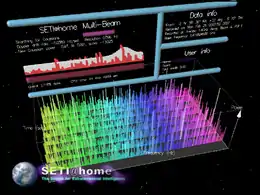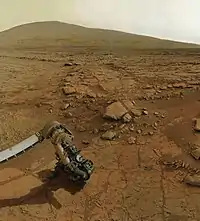Berkeley SETI Research Center
The Berkeley SETI Research Center (BSRC) conducts experiments searching for optical and electromagnetic transmissions from intelligent extraterrestrial civilizations.[1] The center is based at the University of California, Berkeley.
 Berkeley SETI Research Center Logo | |
| Formation | 2012 |
|---|---|
| Purpose | Determine the prevalence of intelligent life in the universe |
| Headquarters | Berkeley, California |
Director | Andrew Siemion |
Parent organization | University of California, Berkeley |
| Website | seti |

 |
| This article is one of a series on: |
| Life in the Universe |
|---|
| Astrobiology |
| Habitability in the Solar System |
| Life outside the Solar System |
The Berkeley SETI Research Center has several SETI searches operating at various wavelengths, from radio, through infrared, to visible light. These include SERENDIP, SEVENDIP, NIROSETI,[2] Breakthrough Listen, and SETI@home. The research center is also involved in the development of new telescopes and instrumentation.
The Berkeley SETI Research Center is independent of, but collaborates with, researchers at the SETI Institute. No unambiguous signals from extraterrestrial intelligence have been found.[3]
Breakthrough Listen
The Berkeley SETI Research Center also hosts the Breakthrough Listen program,[4][5][6] which is a ten-year initiative with $100 million funding begun in July 2015 to actively search for intelligent extraterrestrial communications in the universe, in a substantially expanded way, using resources that had not previously been extensively used for the purpose.[7][8][9] It has been described as the most comprehensive search for alien communications to date.[8] Announced in July 2015, the project is observing for thousands of hours every year on two major radio telescopes, the Green Bank Observatory in West Virginia, the Parkes Observatory in Australia, and the Automated Planet Finder telescope.[1][10]
SETI@home
The center also created the SETI@home, an Internet-based public volunteer computing project employing the BOINC software platform, hosted by their Space Sciences Laboratory. Its purpose is to analyze radio data from radio telescopes for signs of extraterrestrial intelligence.
SERENDIP
The SERENDIP program takes advantage of ongoing "mainstream" radio telescope observations and analyzes deep space radio telescope data that it obtains while other astronomers are using the telescope.[11] SERENDIP observations have been conducted at frequencies between 400 MHz and 5 GHz, with most observations near the so-called Cosmic Water Hole (1.42 GHz (21 cm) neutral hydrogen and 1.66 GHz hydroxyl transitions).[11]
SEVENDIP
SEVENDIP, which stands for Search for Extraterrestrial Visible Emissions from Nearby Developed Intelligent Populations, was a project using visible wavelengths to search for extraterrestrial life's intelligent signals from outer space.[12]
NIROSETI
The NIROSETI (Near-InfraRed Optical Search for Extraterrestrial Intelligence) program searches for artificial signals in the optical (visible) and near infrared (NIR) wavebands of the electromagnetic spectrum.[13][14] It uses the Nickel 1-m telescope at the Lick Observatory in California, USA.[15] The instrument saw its first light on 15 March 2015 and was commissioned on January 2016.
The NIROSETI instrument employs a new generation of near-infrared (900 to 1700 nm) detectors, cooled at -25 °C, that have a high speed response (>1 GHz) and gain comparable to photomultiplier tubes, while also producing very low noise,[14] and significantly reducing false positives.[16] Its field-of-view is 2.5"x2.5" each,[17] and focuses on detecting short (nanosecond) pulsed laser emissions. The NIROSETI instrument is also being used to study variability of very short natural near-infrared transient phenomena.[14][18]
See also
- Active SETI, also called METI (Messaging to Extra-Terrestrial Intelligence)
- Communication with Extraterrestrial Intelligence
- Cultural impact of extraterrestrial contact
- List of astronomical societies
- SETI
- Xenoarchaeology
References
- Berkeley SETI - Home page. Steve Croft, Berkeley SETI Research Center, University of California, Berkeley. 2017.
- SETI Explores the Near-Infrared. Paul Gilster, Centauri Dreams. 27 March 2015.
- Berkeley SETI Research Center - FAQ. 2017.
- "Berkeley SETI". seti.berkeley.edu. Retrieved 2017-09-21.
- "Breakthrough Initiatives". breakthroughinitiatives.org. Retrieved 2017-09-21.
- "Breakthrough Listen Initiative - News from Department of Astronomy". astro.berkeley.edu. Retrieved 2017-09-21.
- Feltman, Rachel (20 July 2015). "Stephen Hawking announces $100 million hunt for alien life". Washington Post. Retrieved 20 July 2015.
- Merali, Zeeya (2015). "Search for extraterrestrial intelligence gets a $100-million boost". Nature. 523 (7561): 392–3. Bibcode:2015Natur.523..392M. doi:10.1038/nature.2015.18016. PMID 26201576.
- Rundle, Michael (20 July 2015). "$100m Breakthrough Listen is 'largest ever' search for alien civilisations". Wired. Retrieved 20 July 2015.
- Sample, Ian (20 July 2015). "Anybody out there? $100m radio wave project to scan far regions for alien life". The Guardian. Retrieved 20 July 2015.
- "SERENDIP". UC Berkeley. Archived from the original on 2013-03-11. Retrieved 2006-08-20.
- "The Search for Extra Terrestrial Intelligence at Berkeley". University of California at Berkeley. Archived from the original on 2012-12-25. Retrieved 5 April 2012.
- SETI Explores the Near-Infrared. Paul Gilster, Centauri Dreams, 27 March 2015.
- A near-infrared SETI experiment: probability distribution of false coincidences (PDF). Jrerome Maire, Shelley A. Wright, Dan Werthimer, Richard R. Treffers, Geoffrey W. Marcy, Remington P. S. Stone, Frank Drake, Andrew Siemion. arXiv. 2014.
- Steven S. Vogt et al., APF - The Lick Observatory Automated Planet Finder, 26 February 2014.
- near-infrared SETI experiment: commissioning, data analysis, and performance results (PDF). Jerome Maire, Shelley A. Wright, Patrick Dorval, Frank D. Drake, Andres Duenas, Howard Isaacson, Geoffrey W. Marcy, Andrew Siemion, Remington P. S. Stone, Melisa Tallis, Richard R. Treffers, and Dan Werthimer. 2016.
- A near-Infrared SETI Experiment: Alignment and Astrometric precision. Duenas, Andres; Maire, Jerome; Wright, Shelley; Drake, Frank D.; Marcy, Geoffrey W.; Siemion, Andrew; Stone, Remington P. S.; Tallis, Melisa; Treffers, Richard R.; Werthimer, Dan. American Astronomical Society, AAS Meeting #228, id.120.04. June 2016.
- Search for extraterrestrial intelligence extends to new realms. University of California. Published by PhysOrg. 20 March 2016.
External links
- Berkeley SETI Research Center Highlights, 5 min video by Berkeley University at YouTube.
- Search for Extraterrestrial Intelligence at Home (SETI@Home)
- Stephen Hawking and Russian tycoon Yuri Milner kick off new search for E.T., $100 million funding to search star catalogue using SETI@home software, July 2015.